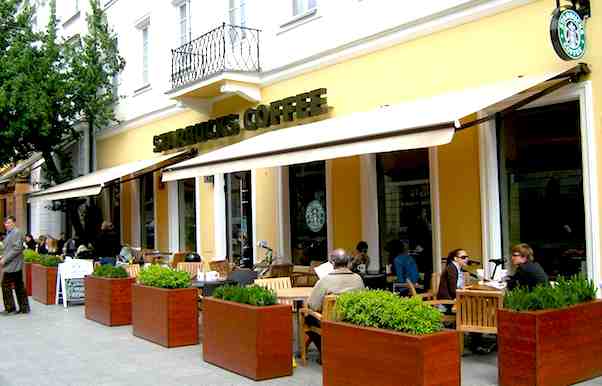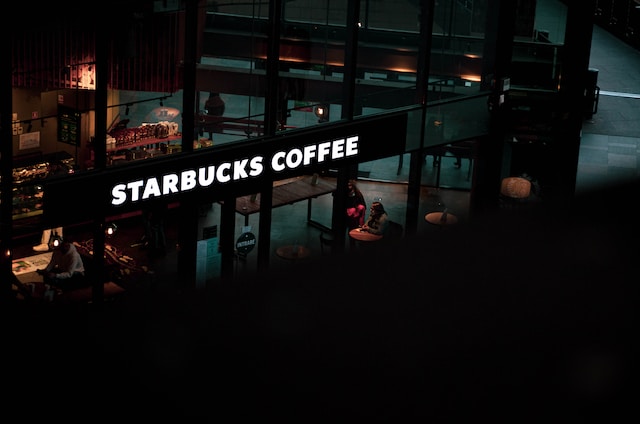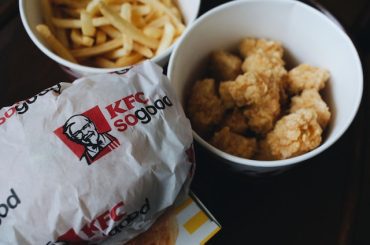
- About / Contact
- Privacy Policy
- Alphabetical List of Companies
- Business Analysis Topics

Starbucks’ Marketing Mix: 4P Analysis

Starbucks Corporation’s marketing mix (4Ps) supports the firm’s industry position as the leading coffeehouse chain in the world. The marketing mix identifies the main components of the coffee company’s marketing plan, namely, product, place, promotion, and price (the four Ps). In this business analysis case, Starbucks uses its 4P to develop its brand image and ensure profitability. With the strongest brand in the coffeehouse industry, the company shows how an effective marketing mix and marketing strategy can support brand development and multinational business growth. Starbucks occasionally changes its 4P to respond to strategic challenges in the market, including competitive forces involving other coffeehouse firms, like Tim Hortons, as well as foodservice companies, like Dunkin’, McDonald’s , Burger King , Wendy’s , and Subway . These competitors challenge the company’s market position, as explained in the Five Forces analysis of Starbucks . The coffee company’s marketing mix functions as a strategic approach to counteract competition.
The marketing mix or 4P is a strategic tool for a unified and systematic approach to bringing Starbucks’ products to food and beverage markets around the world. Based on its 4Ps, the coffeehouse company applies a combination of marketing strategies and tactics to promote the right products at the right places at the right prices. The success of the marketing mix contributes to operational effectiveness and supports Starbucks’ mission statement and vision statement .
This component of the marketing mix focuses on what the coffee business offers to customers. Starbucks Corporation innovates its product mix (and its 4Ps) to capture more of the market. The company modifies food and beverage product lines with the aim of expanding its market reach and growing its market share. The following are the main categories in Starbucks’ product mix:
- At Home Coffee (instant and home-brew coffee)
- Merchandise (cups, tumblers, mugs, etc.)
Starbucks’ product mix is a result of years of business innovation and strategic changes in the marketing mix. For example, the company added the Frappuccino line after acquiring The Coffee Connection in 1994. Today, the business continues its product innovation to offer new foods and beverages that attract and keep more customers. The resulting marketing mix, together with Starbucks’ generic strategy for competitive advantage and intensive strategies for growth , ensures that products match consumer preferences in a diverse international market. Thus, this part of the 4Ps involves beverages, foods, and merchandise that are carefully selected or designed to satisfy the needs and preferences of target consumers worldwide.
Place in Starbucks’ Marketing Mix
This marketing mix component determines the venues where customers access the company’s foods, beverages, and merchandise. Starbucks offers most of its products at cafés or coffeehouses. However, other places or channels of distribution are included in this 4P component. This marketing case shows that Starbucks Corporation distributes its products through the following venues or places to reach target consumers:
- Coffeehouses/Cafés
- Website and mobile apps
Coffeehouses or cafés are the most noticeable distribution venues in Starbucks’ marketing mix. These places are strategically located in areas that have high pedestrian traffic, such as malls and commercial centers. Starbucks’ organizational structure (company structure) facilitates the management of franchising and licensing operations for these store locations. Retailers are also included in the coffeehouse company’s 4Ps, as channels for maximizing distribution and market reach. These places enable the company to distribute coffee products, such as VIA instant coffee and other merchandise. In addition, online venues are in Starbucks’ marketing mix. The company’s website and mobile apps provide easy access for customers who want to check available products or place their orders for pickup or for delivery through third-party service providers. The information technology used in this 4P component addresses the sociocultural and technological trends described in the PESTEL/PESTLE analysis of Starbucks . Thus, the company’s marketing mix involves strategies and tactics that use different types of locations to optimize the distribution of food and beverage products. The high visibility and accessibility of these places contribute to a positive brand image, which is one of the strengths assessed in the SWOT analysis of Starbucks .
Starbucks’ Promotion
In the marketing mix, promotions, also known as the marketing communications mix, refer to communication strategies and tactics for the goal of improving Starbucks’ brand, revenues, and market share. For example, the promotional mix can focus on persuading consumers to buy the company’s tea and instant coffee products. Starbucks’ marketing mix includes the following promotional activities:
- Word-of-mouth marketing
- Advertising
- Sales promotions
- Public relations
Word-of-mouth marketing is the most significant promotional strategy in Starbucks’ marketing mix. The company focuses on high-quality customer experience to encourage people to spread positive reviews that promote the coffeehouse business. Starting with Howard Schultz’s leadership, the emphasis on high quality through Starbucks’ company culture (work culture) helps create such good experiences for customers. In addition, advertising is an integral part of the coffee company’s 4Ps. For example, the company’s coffee and tea ads reach target customers through the Internet and print media. Moreover, the marketing mix involves sales promotions as a communications strategy to persuade consumers to buy more of the company’s foods and beverages. For example, the Starbucks Rewards program provides freebies for customers. In this approach, consumers buy more of the company’s products while expecting freebies, such as free coffee. Furthermore, the company uses public relations to promote its brand and coffee products. In the 4P context, the Starbucks Foundation functions as a part of a public relations strategy. The Foundation assists organizations and communities while promoting the coffeehouse company in the process. Starbucks’ stakeholder management and corporate social responsibility (CSR) and ESG strategy for sustainability and other goals relate to public relations in this marketing mix.
Prices & Pricing Strategy in Starbucks’ 4Ps
Starbucks uses a premium pricing strategy . This strategy involves relatively high price points and price ranges for products that the coffeehouse business presents as superior-quality or high-end (“premium prices” for “premium products”). In the marketing mix context, Starbucks’ pricing strategy takes advantage of the behavioral tendency of consumers to purchase expensive products based on the perception that high prices mean high quality, high value, and high status. This part of the 4P also helps strengthen the premium brand against competitors, like McDonald’s McCafé Premium Roast. Starbucks’ operations management optimizes quality and costs to support the pricing strategy in this marketing mix.
- Reddy, T. N., Ghouse, S. M., & JS, R. K. (2023). Marketing Mix – Review of P. Research Journal of Humanities and Social Sciences, 14 (1), 55-58.
- Solberg, C. A., & Durrieu, F. (2023). Patterns of international marketing strategy. Journal of Business & Industrial Marketing, 38 (7), 1532-1544.
- Starbucks Coffee Company Menu .
- Starbucks Corporation – Form 10-K .
- Starbucks Delivers .
- Starbucks Rewards .
- The Starbucks Foundation .
- U.S. Department of Agriculture – Economic Research Service – Food Service Industry Market Segments .
- Copyright by Panmore Institute - All rights reserved.
- This article may not be reproduced, distributed, or mirrored without written permission from Panmore Institute and its author/s.
- Educators, Researchers, and Students: You are permitted to quote or paraphrase parts of this article (not the entire article) for educational or research purposes, as long as the article is properly cited and referenced together with its URL/link.

Starbucks Marketing Mix (4Ps)

Before we dive deep into the Marketing Mix (4Ps), let’s get the business overview of Starbucks. Starbucks Corporation, founded in Seattle, Washington, in 1971, has grown to become the world’s largest coffeehouse chain and one of the most recognizable brands in the specialty coffee industry. Known for its iconic green mermaid logo, Starbucks has expanded its presence globally, with more than 35,700+ stores in over 80 countries as of 2022.
Business Model : Starbucks operates under a retail and franchise model, with most company-operated stores (51%). The company primarily generates revenue by selling premium coffee and other beverages, including espresso-based drinks, teas, and smoothies. Additionally, Starbucks offers a variety of food items such as sandwiches, salads, pastries, and snacks. The company also sells coffee beans, ground coffee, and single-serve products for at-home consumption.
Starbucks strongly focuses on providing a consistent and comfortable in-store experience, emphasizing customer service and an inviting atmosphere. Many stores offer free Wi-Fi and ample seating to encourage customers to spend time in the stores. The company has also developed a successful loyalty program called Starbucks Rewards, which offers exclusive deals and promotions to members.
Diversification and Expansion: Over the years, Starbucks has diversified its product offerings by launching new lines of beverages, such as the Teavana range of teas, and acquiring other companies, including Evolution Fresh (a cold-pressed juice company) and La Boulange (a bakery chain). The company has also entered the ready-to-drink (RTD) market through partnerships with PepsiCo and Anheuser-Busch InBev.
Furthermore, Starbucks has expanded its operations beyond physical stores by introducing various digital initiatives, such as mobile ordering and payment through the Starbucks app. This has enabled the company to reach new customers and streamline the in-store experience.
Sustainability and Corporate Social Responsibility: Starbucks is committed to addressing social and environmental issues, focusing on ethical sourcing, sustainable packaging, and minimizing its carbon footprint. The company has implemented the Coffee and Farmer Equity (C.A.F.E.) Practices that promote fair trade, improved working conditions, and environmentally responsible farming methods.
Financial Performance : Starbucks generated $32.5 billion in 2022, with a net operating income of $4.6 billion. Total net revenues increased $3.2 billion, or 11%, over fiscal 2021, primarily due to higher revenues from company-operated stores ($2.0 billion). The growth in company-operated store revenue was driven by an 8% increase in comparable store sales ($1.8 billion), attributed to a 5% increase in average ticket and a 2% increase in similar transactions.
Starbucks business model & supply chain analysis
Here is the Marketing Mix (4Ps) for Starbucks
A marketing mix, also known as the 4Ps of marketing, is framework marketers use to develop and implement effective marketing strategies. The concept helps businesses identify and optimize the key components necessary to promote and sell their products or services. The 4Ps of the marketing mix are Product, Price, Place, and Promotion.
In addition to the traditional 4 Ps, marketers have expanded their strategies by incorporating additional elements (People, Process & Performance) to help them better understand and reach their target audiences. But we will focus on the 4Ps as they still are the foundation of any marketing strategy. In this article, we will understand the marketing mix (4Ps) of Starbucks.
What is a Marketing Mix? What are the 4Ps of Marketing?
- Coffee : Starbucks offers a variety of coffee blends, such as espresso, drip-brewed, and cold brew. They have a range of coffee beverages like lattes, cappuccinos, macchiatos, Americanos, and more. Starbucks also sells coffee beans and ground coffee for customers who prefer brewing their coffee at home.
- Non-coffee beverages : In addition to coffee, Starbucks serves an assortment of non-coffee beverages, including teas, hot chocolate, smoothies, and a selection of cold drinks like iced teas, lemonades, and refreshers.
- Food items : Starbucks offers a range of food items, such as pastries, sandwiches, salads, breakfast items, and snacks, to complement its beverages. The menu varies by location and often includes both sweet and savory options.
- Seasonal and limited-time offerings : Starbucks regularly introduces seasonal beverages and food items, like the famous Pumpkin Spice Latte during the fall or the Peppermint Mocha during the holiday season. These limited-time offerings help create a sense of excitement and novelty among customers.
- Merchandise : Starbucks sells branded merchandise, such as mugs, tumblers, coffee makers, and other accessories, both in-store and online. This allows customers to purchase items that represent their affinity for the brand.
- Loyalty program and mobile app : Starbucks’ loyalty program, Starbucks Rewards, and the Starbucks mobile app are also part of the company’s product offerings. These provide customers with a more personalized and convenient experience, including mobile ordering, payment options, and the ability to earn rewards for their purchases.
- Premium pricing : Starbucks sets its prices higher than many competitors, reflecting the premium quality of its products, ingredients, and overall customer experience. This premium pricing strategy contributes to the brand’s image as a high-quality, sophisticated coffee provider and associated products.
- Value perception : Despite higher prices, Starbucks creates a perception of value by offering exceptional customer service, comfortable and inviting store environments, and a diverse product range. This helps justify the premium pricing and enhances the overall customer experience. Starbucks prices products on value, not cost. Why?
- Customization : Starbucks allows customers to customize their beverages, which enables them to create a personalized experience that caters to their taste preferences. While customization options may affect the product’s final price, it also provides a sense of value to the customers, as they can tailor their drinks to their liking.
- Geographic pricing variations : Starbucks adjusts its pricing based on local market conditions, cost structures, and competition. This means that prices for the same product may differ across different locations, countries, or regions.
- Loyalty program and promotions : Starbucks offers its Starbucks Rewards loyalty program, which provides members exclusive benefits, such as free drinks or food items, birthday rewards, and personalized offers. These incentives help build customer loyalty and enhance the perception of value, even with premium pricing.
- Price tiering : Starbucks has introduced different price tiers for some of its products, providing more affordable options alongside its premium offerings. This strategy allows the company to cater to a broader range of customers and remain competitive in various market segments.t
Starbucks SWOT Analysis
- Store locations : Starbucks has a vast network of stores across the globe, with thousands of locations in different countries. The company strategically selects locations for its stores, often placing them in high-traffic areas such as city centers, shopping malls, office buildings, and transportation hubs. This approach ensures maximum visibility and accessibility for customers.
- Store layout and design : Starbucks invests in creating a consistent and appealing store design to provide customers with a comfortable and inviting atmosphere. The store layout typically includes ample seating areas, warm lighting, and elements that reflect the brand’s identity. This consistency in design helps establish a recognizable brand experience and ambiance for customers, regardless of the specific location.
- Drive-thru locations : In response to customer demand and changing preferences, Starbucks has introduced drive-thru locations, allowing customers to purchase their favorite beverages and food items without leaving their vehicles. This enhances convenience and caters to customers in a hurry or who prefer not to enter a physical store.
- Licensed stores and partnerships : Starbucks has partnered with other businesses, such as airports, supermarkets, and hotels, to expand its presence and make its products available to a broader customer base. These partnerships often involve licensed stores operated by the partnering business but offer Starbucks products and adhere to the company’s quality standards.
- E-commerce and mobile app : Starbucks also leverages digital channels to enhance customer convenience. The Starbucks mobile app allows customers to place orders ahead of time, pay for their purchases, and access the Starbucks Rewards loyalty program. Additionally, Starbucks sells merchandise, coffee beans, and other products through its online store.
- Wholesale distribution : Starbucks sells its products, such as coffee beans, bottled beverages, and single-serve coffee pods, through various retail channels, including grocery stores and online retailers. This strategy helps the company reach a broader audience and increase brand exposure.
- Advertising : Starbucks uses various advertising channels, such as print, digital, social media, and out-of-home advertising, to reach its target audience. The company creates visually appealing and engaging content that showcases its products and highlights the brand’s values and commitment to quality. How does Starbucks’ unique promotion strategy aid in its massive success?
- Social media : Starbucks maintains a strong presence on social media platforms like Facebook, Instagram, Twitter, and Pinterest, sharing updates, promotions, and engaging content with its followers. The company uses social media to interact with customers, showcase new products, and create a community around the brand.
- Public relations : Starbucks leverages public relations to generate positive media coverage and maintain a favorable image in the public’s eye. The company often shares news about its corporate social responsibility initiatives, sustainability efforts, and new product launches to create buzz and reinforce its reputation as an industry leader.
- Seasonal and limited-time promotions : Starbucks introduces limited-time offerings and seasonal products, such as the Pumpkin Spice Latte and holiday-themed drinks, to create excitement and encourage customers to visit stores. These promotions often generate significant attention and help the company capitalize on trends and consumer preferences.
- In-store promotions : Starbucks utilizes in-store promotional materials, such as menu boards, signage, and point-of-sale displays, to inform customers about new products, discounts, and special offers. These promotions help drive sales and create an appealing in-store experience.
- Loyalty program : Starbucks Rewards, the company’s loyalty program, is a promotional tool to incentivize repeat purchases and enhance customer loyalty. Members can earn rewards, such as free drinks or food items, and receive personalized offers and promotions.
- Partnerships and collaborations : Starbucks engages in partnerships and collaborations with other brands, artists, and celebrities to create unique, limited-edition products and co-branded experiences. These collaborations generate buzz, attract new customers, and strengthen the brand’s image.
Check out the Marketing Mix of Global Businesses
Related posts.

Concentrated Marketing Strategy with Types & Examples

Differentiated marketing strategy with Types & Examples

Brand Positioning Strategy in Marketing with Types & Examples

Product differentiation Strategy in marketing with types & examples

Integrated Marketing Communication Strategy

Segmentation, Targeting & Positioning (STP) in marketing: Explained with Examples

KFC Marketing Mix (4Ps)

Netflix Marketing Mix (4Ps)
Type above and press Enter to search. Press Esc to cancel.

- Mind Map Maker
- Concept Map Maker
- Bubble Map Maker
- Brace Map Maker
- Sunburst Chart Maker
- Online AI Note Taker
- Timeline Maker
- Tree Diagram Maker
- Fishbone Diagram Maker
- Organizational Chart Maker
- Gantt Chart Maker
- Spider Diagram Maker
- EdrawMind AI
- AI Summarize
- AI Mind map
- AI Article generation
- AI Copywriting
- AI Translation
- --> --> >--> -->